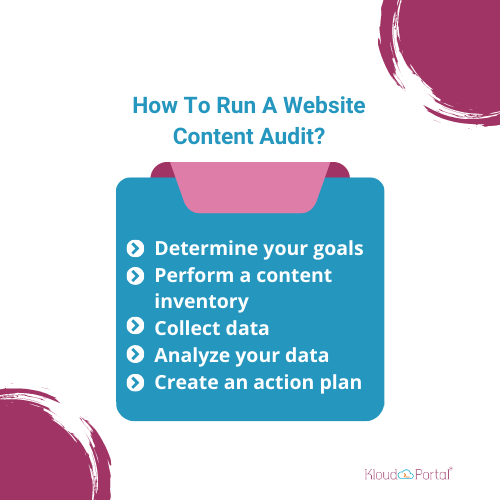What We Cover In This Blog?
When was the last time you thoroughly analyzed and did a complete inventory of your content? The process of doing this analysis and assessing all the content on your website is called a content audit.
Nowadays, most content creators are so preoccupied with producing new content that they don’t pay more attention to auditing their earlier work. And if it has been more than a year, then your content strategy can be based on out-of-date data.
Moreover, Google introduced the ‘Helpful Content Update’ in August 2022, a brand-new ranking factor intended to lessen the visibility of subpar content. And, if your website gets hit with that penalty, then the only method to get out of it is to do content audits.
Simply put, content audits are a clever and strategic approach to assess your previous content marketing efforts and gain a clear understanding of how they aid or impede your goals.
Why Should You Do A Website Content Audit?
A website content audit has a heap of advantages, such as:
- Assisting you in making data-backed decisions about which pages should be properly optimized.
- Highlight the web pages on your site that have poor SEO.
- Locating SEO opportunities and content gaps that you can replace with fresh content.
- Enhancing the reader experience by raising the standard of the content on your website.
- Identify the content you can reuse.
- Make a thorough inventory of your content to simplify future content marketing strategies.
- Enhancing the diversity and accessibility of your content.
How To Run A Website Content Audit?
You should review your content marketing strategy at least once a year to ensure your methods and activities align with your business’s objectives. Although a complete content audit process may be time-consuming, dividing it into small steps is simple.
1. Determine your goals
The first step is to consider your business goals, such as improving your search engine optimization (SEO), content quality, increasing audience engagement, and conversion optimization. Once your goals have been established, you must align them with pertinent content metrics.
Content metrics include SEO metrics (organic traffic, backlinks, keyword rankings, dwell time, etc.), user behavior metrics (page views, average session duration, bounce rate, etc.), engagement metrics ( likes, shares, comments, mentions, etc.) and sales metrics (number of leads, ROI, conversion rates, etc.).
For instance, if you want to identify the most popular topic and provide more content to them, then you should analyze user behavior and engagement metrics. And if you intend to concentrate on your SEO performance, check the number of backlinks and examine your rankings in search engines. Then place the most engaging and effective content on your homepage for your website visitors to win in organic search.
2. Perform a content inventory
Before compiling a list of URLs and metrics, reviewing the existing content is critical. You may check the internal content, such as blog posts, news articles, instructional materials, product descriptions, landing pages, and external publications.
Then, begin your inventory by gathering all the URLs for the websites you wish to analyze. The best approach to collect these is to utilize an online content audit tool that can swiftly audit your content based on your sitemap data and provide you with a list of URLs and related metrics.
A reputed digital marketing agency can guide you in selecting the best analytics tools.
After gathering your URLs, using a content auditing tool or content audit templates, catalog your content by the following categories:
- Content types like blog posts, product descriptions, website pages, or a landing page
- Content format like text only, images or videos present, with or without a call to action
- Word count
- Meta descriptions
- Date of publication or latest modified
- Author
Finally, establish columns with your metrics to identify content for each web page and ensure all pertinent data points are included.

3. Collect data
Obtain data from several sources, then manually enter it into your content audit spreadsheet or download a content audit template. And if you want to save time, use content audit tools that automatically gather information based on your objectives and KPIs. To expand and deepen your data, link your Google Analytics account and Google Search Console. It provides in-depth insights, and for each URL, you can examine more stats, such as sessions, average session length, page views, page title tags, average time on page, bounce rate, and search queries.4. Analyze your data
At this point, it’s time to examine your data closely. This stage will provide you with a reliable assessment of your content assets. Some factors to consider while assessing your data include missing information, underperforming content, outdated information, and home run content. Then, based on the findings of this study, sort the information in the spreadsheet. Depending on your examination, you may assign various colors and highlight the rows with those colors.5. Create an action plan
At this phase, based on the analysis, you now know what to prioritize and can go forward. Consider which old site content you should edit, rewrite, or reorganize. For example, remove low-quality pages that don’t target keywords or offer your readers little value. Also, individual pages may not receive organic traffic, but they may offer valuable context to Google through internal links. In that case, choose where you think it is viable to raise page quality and optimize older content for certain organic searches. After you’ve sorted your priority list, make an action plan for each piece of content. And to ensure that you can monitor it, add one last column to the spreadsheet, preferably one towards the top. You may use this column to determine what to do on a URL. For instance, will you rewrite, update, delete, or keep that blog post? You can also utilize a website content audit checklist to ensure your audit is done correctly.How Can KloudPortal Help?
KloudPortal’s top digital marketing services outline which approach is best for your company, which strategy is geared at, and how to reach the audience. Its free website SEO audit provides you with information and areas for improvement. Also, the well-known digital marketing agency provides various digital transformation solutions, including social media advertising, content development and optimization, SEO services, and sales services. So, why wait? Schedule a meeting with our experts today.
Bishnu Priya
About The Author…
Bishnupriya Pradhan hails from the serene hill station in Odisha, Koraput. As a Veterinary Science and Animal Husbandry graduate, she has served as a Veterinary Assistant Surgeon for the Government of Odisha and also worked as a Research Associate in Bharat Biotech’s RCC Laboratories, Hyderabad. Researching and writing on diverse topics has always been her passion. She chose to be a content writer to exercise her writing skills and creativity and produce a quality write-up that can reach scores of online readers.

